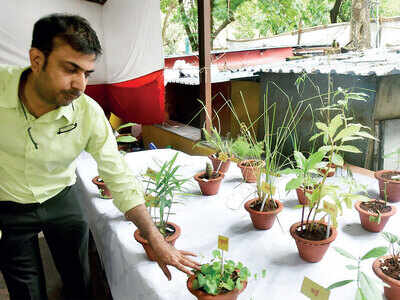Ganesh mandals conserve 21 poojapatri plants

Sahjeevan Ganesh Mandal has exhibited 21 plants used in rites, like rubber bush, bor, maka, deodar, etc; they are being offered for free
As many as 21 varieties of plant leaves comprise ‘poojapatri’ that is offered as a part of rituals during Ganeshotsav festivities. This practice, according to experts, is harming the environment since many of these plants are deemed rare — plucked right out of their natural surroundings. This damage has been taken up seriously by Ganpati mandals creating conservation awareness.
Undirmari, subabul, Australianacacia , gudmai, raintree, sitaphal, ramphal, kurdu, and others are some plants offered in rituals. Some come from Vapi, Gujarat, coastal areas and the Western Ghats . Since the species are endemic to these regions, they have become a rarity. Circumstances have already presented signs of deterioration as certain varieties of Curcuma pseudomontana (wild turmeric) and Zingiber diwakarii (wild ginger), predominantly used in poojapatri, are already rare and in some parts, unavailable.
This has ignited a conscience among mandals, which have commenced an effort on an individual level. “We have exhibited all 21 varieties of plants used at temples to create awareness among visitors,” said Rohan Purkar, president of Sahjeevan Ganesh Mandal at Sahakarnagar.
datura , pimpal, ranvanga, kevda, chaff flower, pomegranate , holy basil, durva and marva are displayed and offered to people for free. “We also plan to set up a dense plantation of all these varieties and native trees in the temple premises this year,” Purkar said.
Akhil Laxminagar Rahivasi Sangh Sarvajanik Ganesh Utsav Mandal was also seen taking a front foot on the cause. Mandal president Kiran Pol said, “People are unaware about wrong varieties being used in poojapatri, in turn impacting the nature. We decided to publish the information in a report and 804 families in the vicinity have been gifted with holy basil (tulsi) plant to create awareness on the same.”
Similarly, Arneshwar Mitra Mandal Gavdiwada is not far behind, with its members taking to counselling visitors. One member, Amit Paygude, told Mirror, “Visitors are personally told that people are exploiting nature. It is also shared how residents can plant many of the varieties at home and contribute to conservation efforts.”
A dearth of knowledge has led to rampant sale of these plants, according to scientists and bio-conservationists, like Sachin Punekar. He said that around six of the 21 plants are less abundant, making it important to conserve them. Overall, 21 varieties are mainly seasonal and have medicinal value. “The idea of putting them into religious scriptures is scientific in nature. These plants act as healing agents for common cough, cold and other minor diseases reported during monsoon,” he added.
However, Punekar emphasised on the need for awareness among people and sellers. “A drive in this regard was held last year during the Ganpati festival to make them aware, too,” Punekar told Mirror.
Undirmari, subabul, Australian
This has ignited a conscience among mandals, which have commenced an effort on an individual level. “We have exhibited all 21 varieties of plants used at temples to create awareness among visitors,” said Rohan Purkar, president of Sahjeevan Ganesh Mandal at Sahakarnagar.
He added that plant varieties like arjun, madhumalti, vishnukant, rubber bush, khejri tree, agati, bor, maka, jai, oleander, bel, deodar,
Akhil Laxminagar Rahivasi Sangh Sarvajanik Ganesh Utsav Mandal was also seen taking a front foot on the cause. Mandal president Kiran Pol said, “People are unaware about wrong varieties being used in poojapatri, in turn impacting the nature. We decided to publish the information in a report and 804 families in the vicinity have been gifted with holy basil (tulsi) plant to create awareness on the same.”
Similarly, Arneshwar Mitra Mandal Gavdiwada is not far behind, with its members taking to counselling visitors. One member, Amit Paygude, told Mirror, “Visitors are personally told that people are exploiting nature. It is also shared how residents can plant many of the varieties at home and contribute to conservation efforts.”
A dearth of knowledge has led to rampant sale of these plants, according to scientists and bio-conservationists, like Sachin Punekar. He said that around six of the 21 plants are less abundant, making it important to conserve them. Overall, 21 varieties are mainly seasonal and have medicinal value. “The idea of putting them into religious scriptures is scientific in nature. These plants act as healing agents for common cough, cold and other minor diseases reported during monsoon,” he added.
However, Punekar emphasised on the need for awareness among people and sellers. “A drive in this regard was held last year during the Ganpati festival to make them aware, too,” Punekar told Mirror.
GALLERIES View more photos








































Recent Messages ()
Please rate before posting your Review
SIGN IN WITH
Refrain from posting comments that are obscene, defamatory or inflammatory, and do not indulge in personal attacks, name calling or inciting hatred against any community. Help us delete comments that do not follow these guidelines by marking them offensive. Let's work together to keep the conversation civil.